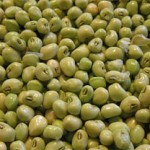 Field pea are one of the oldest domesticated crops, with archaeological evidence showing they were brought under cultivation in the Stone Age, more than 20,000 years ago. They are now grown in many countries for both human consumption and stockfeed.
Field pea are one of the oldest domesticated crops, with archaeological evidence showing they were brought under cultivation in the Stone Age, more than 20,000 years ago. They are now grown in many countries for both human consumption and stockfeed.
Field Peas are a good source of dietary proteins and energy. The starch content, which can vary from 30 to 50 per cent, is high, and comparable to Angustifolius Lupins. The fat content of Field pea is very low (approx. 1%) as are the levels of fibre and lignin, while the content of soluble carbohydrate (mostly starch) is high. The protein content of Field pea is lower than Angustifolius Lupins at 23%.
The metabolised energy content of Field pea for ruminant and non-ruminant animals is high due to the high content of soluble carbohydrates. In poultry diets, Field pea has a significantly higher metabolisable energy value than soybean meal. Field pea are low in calcium, sodium and possibly copper, depending on soil conditions.
